Eunwoo Song
Training Universal Vocoders with Feature Smoothing-Based Augmentation Methods for High-Quality TTS Systems
Sep 04, 2024



Abstract:While universal vocoders have achieved proficient waveform generation across diverse voices, their integration into text-to-speech (TTS) tasks often results in degraded synthetic quality. To address this challenge, we present a novel augmentation technique for training universal vocoders. Our training scheme randomly applies linear smoothing filters to input acoustic features, facilitating vocoder generalization across a wide range of smoothings. It significantly mitigates the training-inference mismatch, enhancing the naturalness of synthetic output even when the acoustic model produces overly smoothed features. Notably, our method is applicable to any vocoder without requiring architectural modifications or dependencies on specific acoustic models. The experimental results validate the superiority of our vocoder over conventional methods, achieving 11.99% and 12.05% improvements in mean opinion scores when integrated with Tacotron 2 and FastSpeech 2 TTS acoustic models, respectively.
Unified Speech-Text Pretraining for Spoken Dialog Modeling
Feb 08, 2024

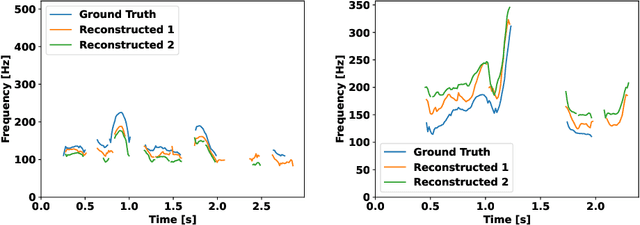

Abstract:While recent work shows promising results in expanding the capabilities of large language models (LLM) to directly understand and synthesize speech, an LLM-based strategy for modeling spoken dialogs remains elusive and calls for further investigation. This work proposes an extensive speech-text LLM framework, named the Unified Spoken Dialog Model (USDM), to generate coherent spoken responses with organic prosodic features relevant to the given input speech without relying on automatic speech recognition (ASR) or text-to-speech (TTS) solutions. Our approach employs a multi-step speech-text inference scheme that leverages chain-of-reasoning capabilities exhibited by the underlying LLM. We also propose a generalized speech-text pretraining scheme that helps with capturing cross-modal semantics. Automatic and human evaluations show that the proposed approach is effective in generating natural-sounding spoken responses, outperforming both prior and cascaded baselines. Detailed comparative studies reveal that, despite the cascaded approach being stronger in individual components, the joint speech-text modeling improves robustness against recognition errors and speech quality. Demo is available at https://unifiedsdm.github.io.
Pruning Self-Attention for Zero-Shot Multi-Speaker Text-to-Speech
Aug 28, 2023Abstract:For personalized speech generation, a neural text-to-speech (TTS) model must be successfully implemented with limited data from a target speaker. To this end, the baseline TTS model needs to be amply generalized to out-of-domain data (i.e., target speaker's speech). However, approaches to address this out-of-domain generalization problem in TTS have yet to be thoroughly studied. In this work, we propose an effective pruning method for a transformer known as sparse attention, to improve the TTS model's generalization abilities. In particular, we prune off redundant connections from self-attention layers whose attention weights are below the threshold. To flexibly determine the pruning strength for searching optimal degree of generalization, we also propose a new differentiable pruning method that allows the model to automatically learn the thresholds. Evaluations on zero-shot multi-speaker TTS verify the effectiveness of our method in terms of voice quality and speaker similarity.
* INTERSPEECH 2023
Period VITS: Variational Inference with Explicit Pitch Modeling for End-to-end Emotional Speech Synthesis
Oct 28, 2022



Abstract:Several fully end-to-end text-to-speech (TTS) models have been proposed that have shown better performance compared to cascade models (i.e., training acoustic and vocoder models separately). However, they often generate unstable pitch contour with audible artifacts when the dataset contains emotional attributes, i.e., large diversity of pronunciation and prosody. To address this problem, we propose Period VITS, a novel end-to-end TTS model that incorporates an explicit periodicity generator. In the proposed method, we introduce a frame pitch predictor that predicts prosodic features, such as pitch and voicing flags, from the input text. From these features, the proposed periodicity generator produces a sample-level sinusoidal source that enables the waveform decoder to accurately reproduce the pitch. Finally, the entire model is jointly optimized in an end-to-end manner with variational inference and adversarial objectives. As a result, the decoder becomes capable of generating more stable, expressive, and natural output waveforms. The experimental results showed that the proposed model significantly outperforms baseline models in terms of naturalness, with improved pitch stability in the generated samples.
Language Model-Based Emotion Prediction Methods for Emotional Speech Synthesis Systems
Jul 01, 2022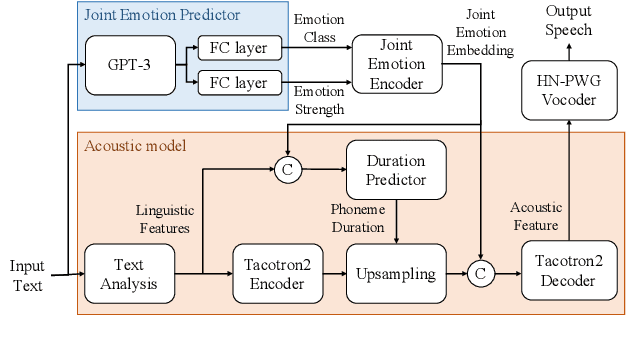

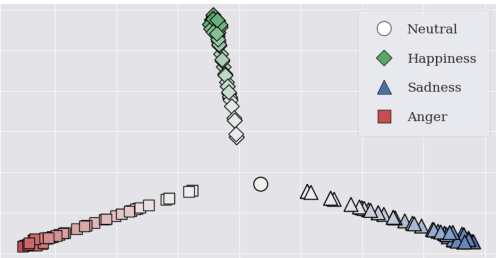

Abstract:This paper proposes an effective emotional text-to-speech (TTS) system with a pre-trained language model (LM)-based emotion prediction method. Unlike conventional systems that require auxiliary inputs such as manually defined emotion classes, our system directly estimates emotion-related attributes from the input text. Specifically, we utilize generative pre-trained transformer (GPT)-3 to jointly predict both an emotion class and its strength in representing emotions coarse and fine properties, respectively. Then, these attributes are combined in the emotional embedding space and used as conditional features of the TTS model for generating output speech signals. Consequently, the proposed system can produce emotional speech only from text without any auxiliary inputs. Furthermore, because the GPT-3 enables to capture emotional context among the consecutive sentences, the proposed method can effectively handle the paragraph-level generation of emotional speech.
TTS-by-TTS 2: Data-selective augmentation for neural speech synthesis using ranking support vector machine with variational autoencoder
Jun 30, 2022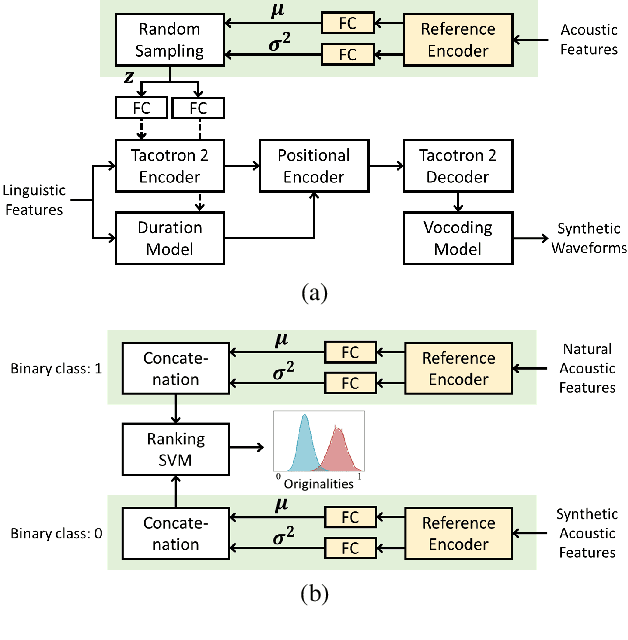

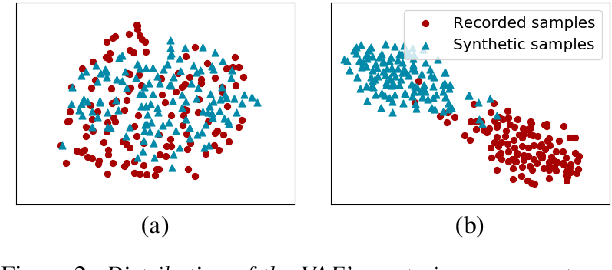
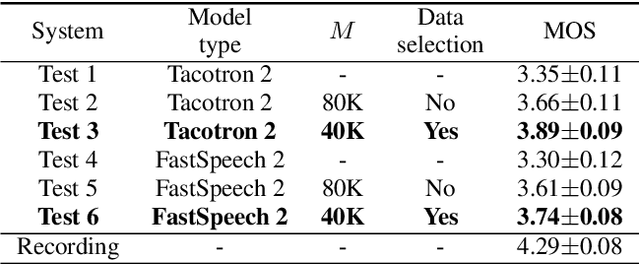
Abstract:Recent advances in synthetic speech quality have enabled us to train text-to-speech (TTS) systems by using synthetic corpora. However, merely increasing the amount of synthetic data is not always advantageous for improving training efficiency. Our aim in this study is to selectively choose synthetic data that are beneficial to the training process. In the proposed method, we first adopt a variational autoencoder whose posterior distribution is utilized to extract latent features representing acoustic similarity between the recorded and synthetic corpora. By using those learned features, we then train a ranking support vector machine (RankSVM) that is well known for effectively ranking relative attributes among binary classes. By setting the recorded and synthetic ones as two opposite classes, RankSVM is used to determine how the synthesized speech is acoustically similar to the recorded data. Then, synthetic TTS data, whose distribution is close to the recorded data, are selected from large-scale synthetic corpora. By using these data for retraining the TTS model, the synthetic quality can be significantly improved. Objective and subjective evaluation results show the superiority of the proposed method over the conventional methods.
Cross-Speaker Emotion Transfer for Low-Resource Text-to-Speech Using Non-Parallel Voice Conversion with Pitch-Shift Data Augmentation
Apr 21, 2022



Abstract:Data augmentation via voice conversion (VC) has been successfully applied to low-resource expressive text-to-speech (TTS) when only neutral data for the target speaker are available. Although the quality of VC is crucial for this approach, it is challenging to learn a stable VC model because the amount of data is limited in low-resource scenarios, and highly expressive speech has large acoustic variety. To address this issue, we propose a novel data augmentation method that combines pitch-shifting and VC techniques. Because pitch-shift data augmentation enables the coverage of a variety of pitch dynamics, it greatly stabilizes training for both VC and TTS models, even when only 1,000 utterances of the target speaker's neutral data are available. Subjective test results showed that a FastSpeech 2-based emotional TTS system with the proposed method improved naturalness and emotional similarity compared with conventional methods.
Improved parallel WaveGAN vocoder with perceptually weighted spectrogram loss
Jan 19, 2021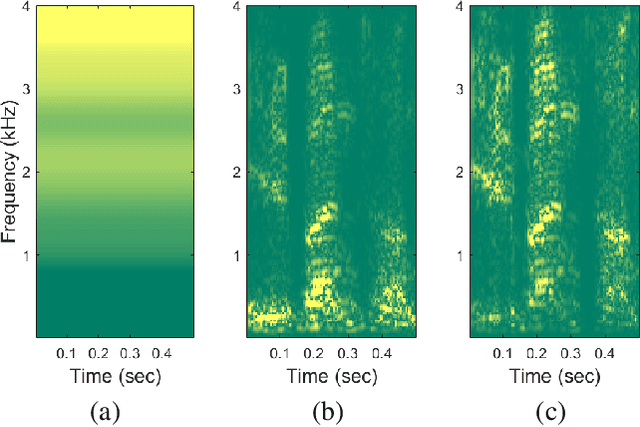

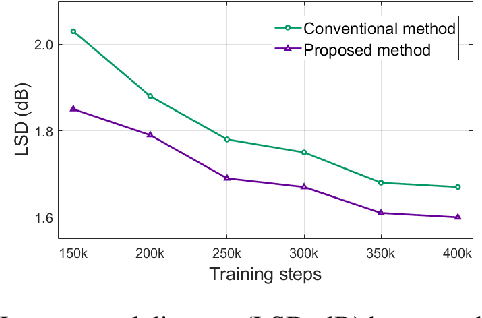

Abstract:This paper proposes a spectral-domain perceptual weighting technique for Parallel WaveGAN-based text-to-speech (TTS) systems. The recently proposed Parallel WaveGAN vocoder successfully generates waveform sequences using a fast non-autoregressive WaveNet model. By employing multi-resolution short-time Fourier transform (MR-STFT) criteria with a generative adversarial network, the light-weight convolutional networks can be effectively trained without any distillation process. To further improve the vocoding performance, we propose the application of frequency-dependent weighting to the MR-STFT loss function. The proposed method penalizes perceptually-sensitive errors in the frequency domain; thus, the model is optimized toward reducing auditory noise in the synthesized speech. Subjective listening test results demonstrate that our proposed method achieves 4.21 and 4.26 TTS mean opinion scores for female and male Korean speakers, respectively.
Parallel waveform synthesis based on generative adversarial networks with voicing-aware conditional discriminators
Oct 27, 2020



Abstract:This paper proposes voicing-aware conditional discriminators for Parallel WaveGAN-based waveform synthesis systems. In this framework, we adopt a projection-based conditioning method that can significantly improve the discriminator's performance. Furthermore, the conventional discriminator is separated into two waveform discriminators for modeling voiced and unvoiced speech. As each discriminator learns the distinctive characteristics of the harmonic and noise components, respectively, the adversarial training process becomes more efficient, allowing the generator to produce more realistic speech waveforms. Subjective test results demonstrate the superiority of the proposed method over the conventional Parallel WaveGAN and WaveNet systems. In particular, our speaker-independently trained model within a FastSpeech 2 based text-to-speech framework achieves the mean opinion scores of 4.20, 4.18, 4.21, and 4.31 for four Japanese speakers, respectively.
Parallel WaveGAN: A fast waveform generation model based on generative adversarial networks with multi-resolution spectrogram
Oct 25, 2019



Abstract:We propose Parallel WaveGAN, a distillation-free, fast, and small-footprint waveform generation method using a generative adversarial network. In the proposed method, a non-autoregressive WaveNet is trained by jointly optimizing multi-resolution spectrogram and adversarial loss functions, which can effectively capture the time-frequency distribution of the realistic speech waveform. As our method does not require density distillation used in the conventional teacher-student framework, the entire model can be easily trained even with a small number of parameters. In particular, the proposed Parallel WaveGAN has only 1.44 M parameters and can generate 24 kHz speech waveform 28.68 times faster than real-time on a single GPU environment. Perceptual listening test results verify that our proposed method achieves 4.16 mean opinion score within a Transformer-based text-to-speech framework, which is comparative to the best distillation-based Parallel WaveNet system.
 Add to Chrome
Add to Chrome Add to Firefox
Add to Firefox Add to Edge
Add to Edge